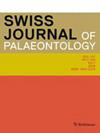中国西南中三叠世的一种新的棘皮龙(爬行动物门:Sauropterygia)及其系统发育和生物地理学意义
IF 3
2区 地球科学
Q1 PALEONTOLOGY
引用次数: 0
摘要
在毁灭性的二叠纪-三叠纪大灭绝之后,一些新的大型爬行动物掠食者群体在三叠纪早期入侵海洋。在这些食肉动物中,由胎龙类、厚背龙类、矛龙类和活龙类(包括标志性的矛龙类)组成的长颈龙类在属和种的层次上都表现出了最大的多样性,并从早三叠世一直延续到晚白垩世。在此,我们报告了一个新的厚鼻龙类物种--Dianmeisaurus mutaensis sp.该新种的唯一已知标本采集于中国南方云南省泸西县木塔村附近的采石场。我们基于一个新的数据矩阵进行了新的系统发生分析,发现该新类群与中三叠世罗平生物群中的小型棘皮龙 Dianmeisaurus gracilis 是姊妹群。新的系统发育分析还打破了传统意义上的Eusauropterygia的单系性。腕龙属(Pistosauroidea)、马家山龙属(Majiashanosaurus)和汉龙属(Hanosaurus)连续成为包括厚鼻龙属(Pachypleurosauria)和腕龙属(Nothosauroidea)在内的新支系的姐妹群。本研究发现了一个单系的厚鼻龙类,其中由滇缅龙和盘喙龙组成的支系处于最基干的位置。由滇缅龙和盘龙组成的支系是本研究中其余厚鼻龙的姊妹群。由于滇缅龙、盘瓠龙、道崎龙和滇鹟龙都是华南地区的唯一已知龙类,我们的研究为厚背龙的古地理起源于特提斯东部的假说提供了进一步的证据。本文章由计算机程序翻译,如有差异,请以英文原文为准。
A new pachypleurosaur (Reptilia: Sauropterygia) from the Middle Triassic of southwestern China and its phylogenetic and biogeographic implications
After the devastating Permo-Triassic Mass Extinction, several new groups of large reptilian predators invaded the sea in the early part of the Triassic. Among these predators, sauropterygians, consisting of placodonts, pachypleurosaurs, nothosaurs and pistosaurs (including the iconic plesiosaurs), displayed the greatest diversity at both the generic and species levels, and persisted from the Early Triassic to the Late Cretaceous. Here, we report a new species of Pachypleurosauria, Dianmeisaurus mutaensis sp. nov., from a recently discovered Lagerstätte in the Upper Member of the Anisian Guanling Formation. The only known specimen of the new species was collected from a quarry near Muta village, Luxi County, Yunnan Province, South China. Our new phylogenetic analysis based on a novel data matrix recovered the new taxon as a sister group to Dianmeisaurus gracilis—a small pachypleurosaur from the Middle Triassic Luoping biota. The new phylogenetic analysis also collapsed the monophyly of the traditionally recognized Eusauropterygia. Pistosauroidea, Majiashanosaurus, and Hanosaurus comprise the consecutive sister groups to a new clade including Pachypleurosauria and Nothosauroidea. A monophyletic Pachypleurosauria, within which the clade consisting of Dianmeisaurus and Panzhousaurus occupies the basal-most position, is recovered by this study. The clade consisting of Dawazisaurus and Dianopachysaurus forms the sister group to the remaining pachypleurosaurs included in this study. Since Dianmeisaurus, Panzhousaurus, Dawazisaurus, and Dianopachysaurus are all exclusively known from South China, our study provides further evidence to the hypothesis that pachypleurosaurs had a palaeobiogeographic origin in the eastern Tethys.
求助全文
通过发布文献求助,成功后即可免费获取论文全文。
去求助
来源期刊

Swiss Journal of Palaeontology
Earth and Planetary Sciences-Paleontology
CiteScore
4.30
自引率
16.70%
发文量
17
审稿时长
4 weeks
期刊介绍:
The Swiss Journal of Palaeontology publishes original research and review articles of interest to the international community in the fields of palaeontology, taxonomy and systematics, while recognising at the same time the importance of documenting high-quality palaeontological data in a regional context. Palaeobiology in combination with alpha taxonomy is a core topic of the journal.
Submitted papers should have an appeal as wide as possible, directed towards an international readership. Contributions should not have been simultaneously submitted elsewhere, and the overlap of content between related articles should be minimal. Duplications of text and the use of previously published illustrations without adequate citation are unacceptable. If a manuscript has two or more authors, both or all have to sign to confirm they all were involved in the work and have agreed to its submission. The preferred manuscript language is UK English, but consistently used US English is also acceptable. We encourage the publication of proceedings of international meetings as well as special thematic issues. Short contributions and book reviews are also accepted.
An international editorial team as well as guest editors guarantee that the thematic issues as well as all articles in regular issues are peer-reviewed and meet the highest standards.
 求助内容:
求助内容: 应助结果提醒方式:
应助结果提醒方式:


